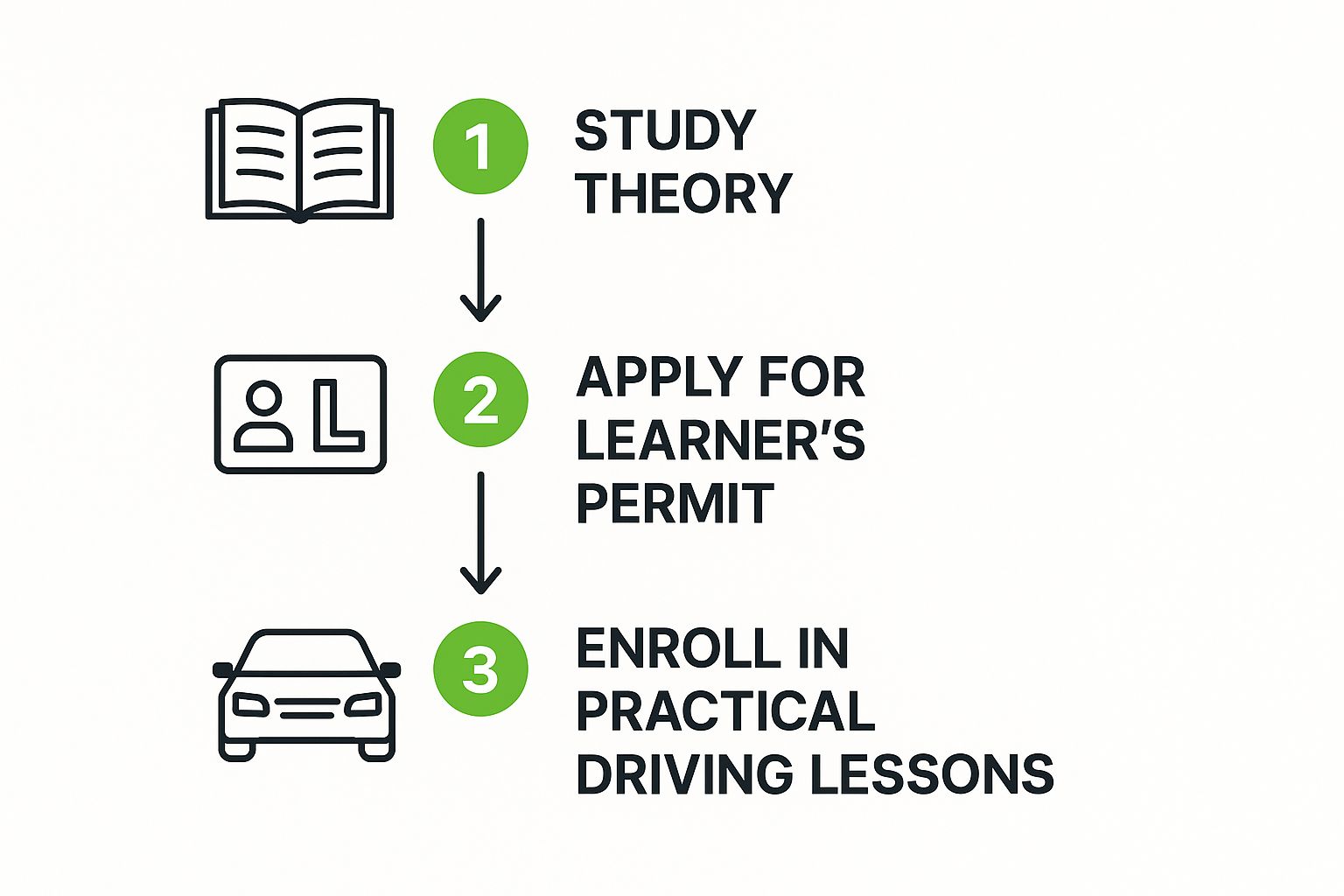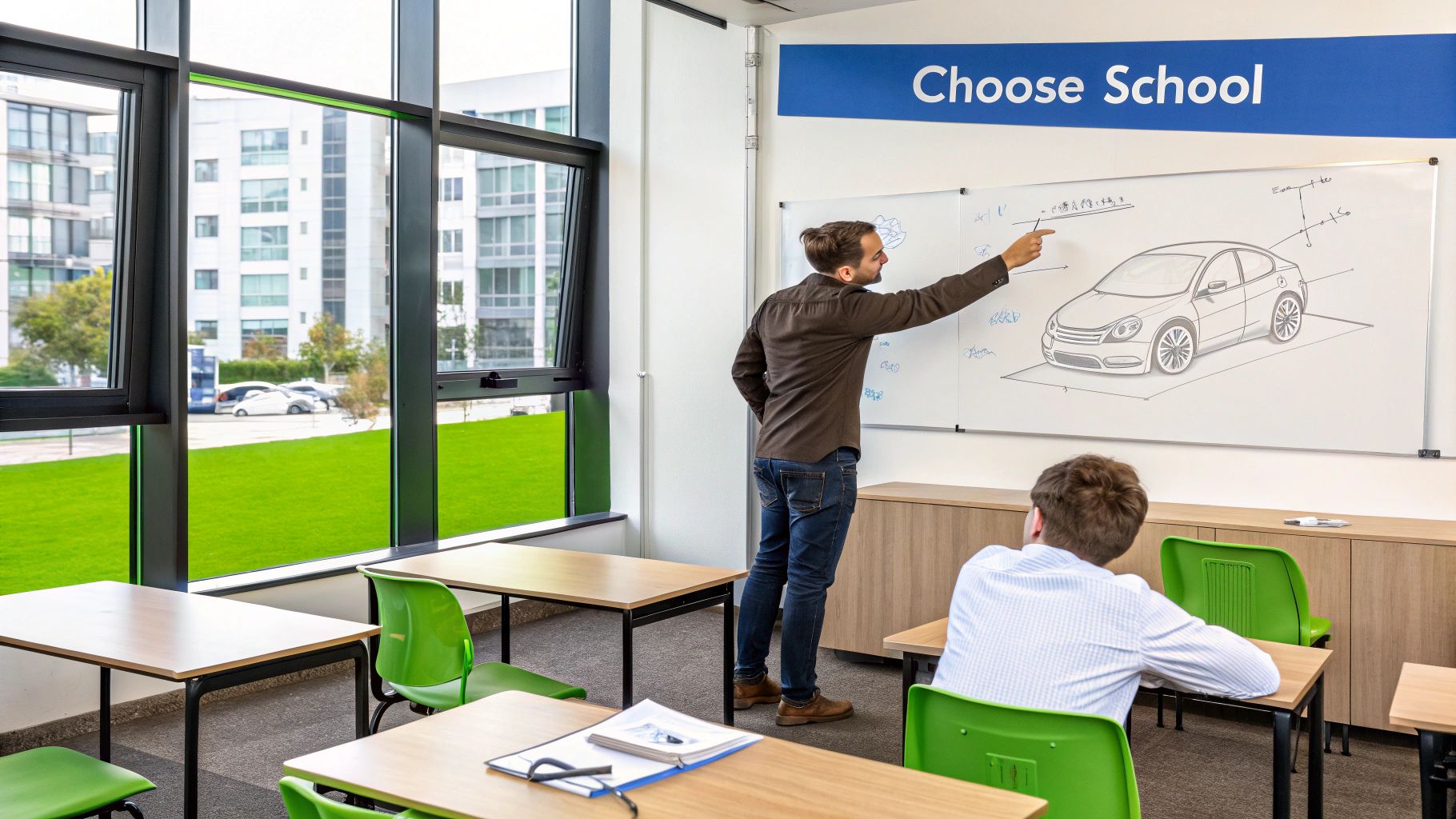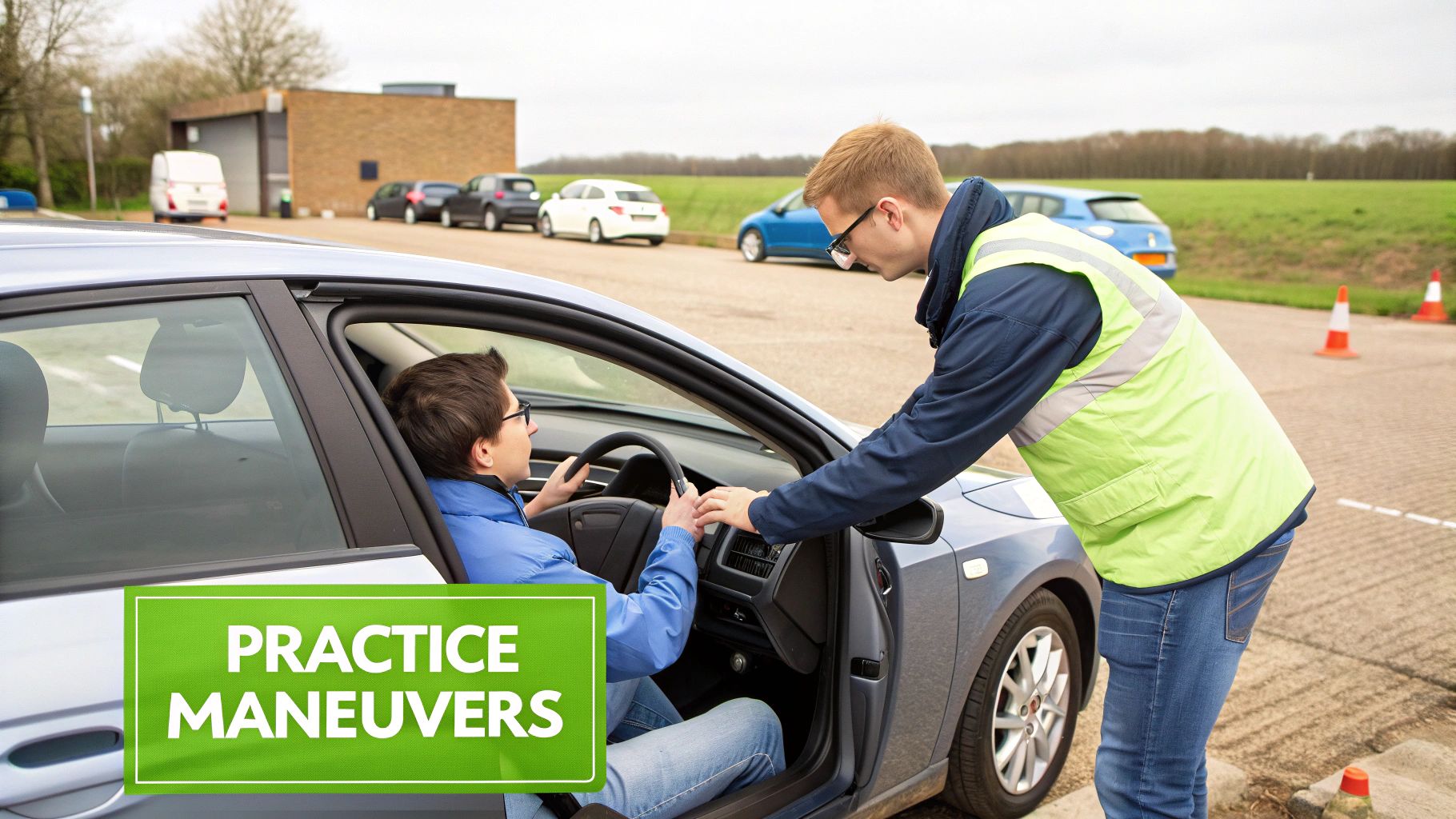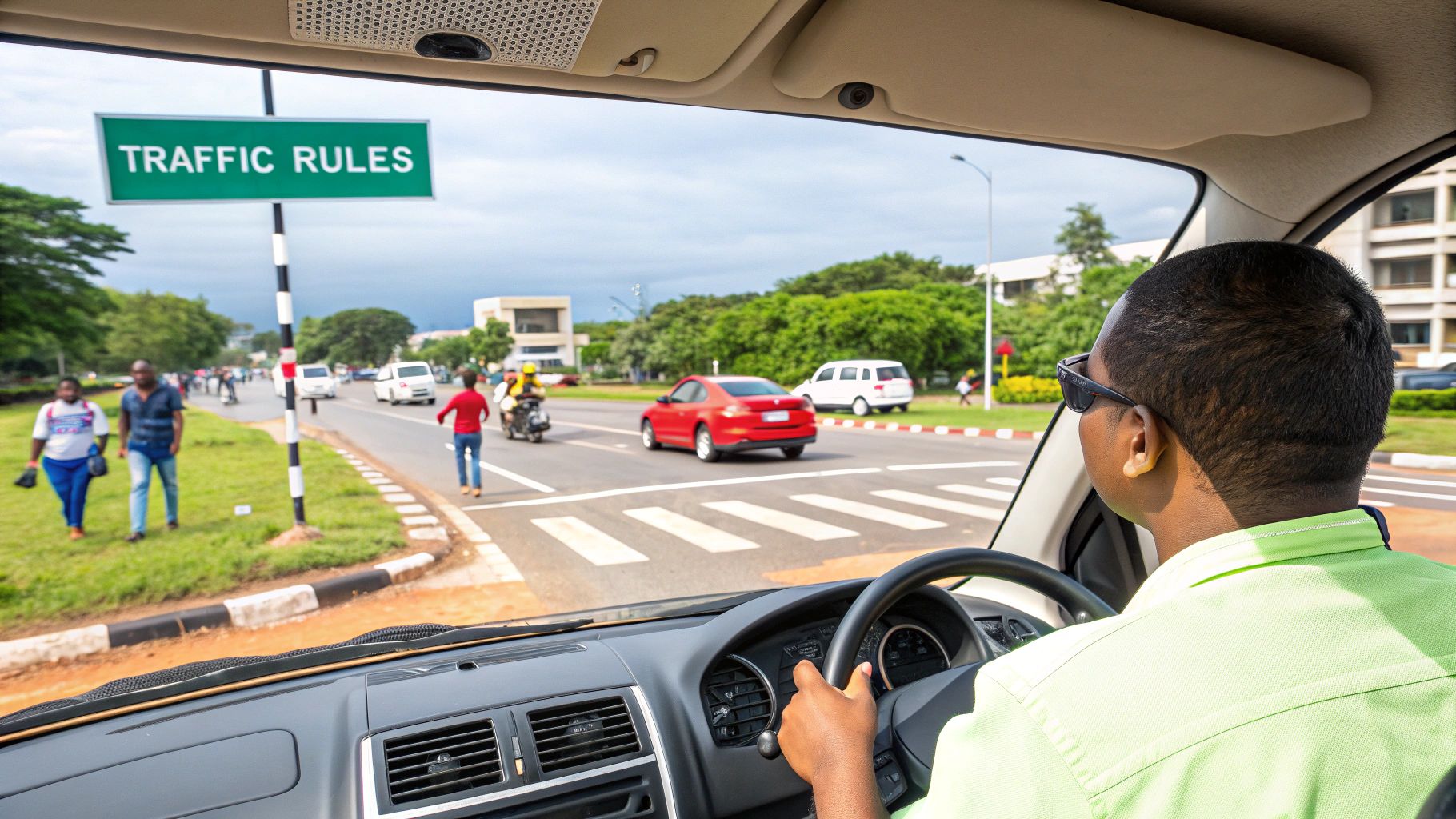Right, let's get you started. Before you can even think about what car you'll be learning in, there are a few bits of essential admin to sort out. Getting these sorted first is non-negotiable in the UK, but think of it as laying the groundwork for everything that comes next.
It’s all about building a solid legal foundation so you can start your lessons without any last-minute hitches or bureaucratic headaches. Nail these steps from the get-go, and you're setting yourself up for a much smoother journey to getting that full licence.
Your First Steps Before Hitting the Road
The very first thing on your to-do list? Getting your hands on a provisional driving licence. You simply can't drive on UK roads without one, not even with a professional instructor sitting next to you.
Securing Your Provisional Licence
Applying for your provisional licence is pretty straightforward, but there are a few boxes you absolutely have to tick. These rules are there for a reason—to make sure every learner is ready for the responsibility of being on the road.
You can actually apply for your licence as soon as you're 15 years and 9 months old, though you'll have to wait until you turn 17 to start driving a car. The quickest way to do it is online through the official GOV.UK website. If you prefer, you can also apply by post.
To be eligible, you'll need to meet these conditions:
- Age: Be at least 15 years and 9 months old.
- Residency: Live in Great Britain.
- Eyesight: Be able to read a standard car number plate from 20 metres away. If you need glasses or contact lenses to do this, that’s fine, but you'll have to wear them every time you drive. They'll check this again at the start of your practical test, so no fibbing!
- Identity: Have proof of who you are, like a valid UK passport.
Here's a pro tip: Apply for your provisional licence well before your 17th birthday. It can sometimes take a few weeks to arrive, and having it ready means you can book that first lesson for the big day itself.
Understanding the Initial Costs
It's wise to get a handle on the initial costs before you start, as it's not just about the price of the lessons themselves. First up, the provisional licence application will set you back £34 if you apply online, or £43 if you go the postal route.
Then there's insurance to think about. Your instructor's car is, of course, fully insured for your lessons. However, if you're planning on getting extra practice in a friend's or family member's car—which I highly recommend for building up your experience—you'll need separate cover.
You can either be added as a named driver to their policy or, more commonly, take out a specific learner driver insurance policy. These are usually quite flexible, with monthly options available. Crucially, they protect the car owner's precious No Claims Bonus if you have a little bump.
Mastering the Driving Theory Test
Before you can even think about getting behind the wheel for your practical test, you've got to conquer the theory test. This isn't just a box-ticking exercise; it's the foundation of everything you'll do as a driver. It’s about building a solid understanding of the rules of the road and, just as importantly, learning to spot trouble before it happens. Forget last-minute cramming – a smart, steady approach is what gets you through.
The test itself is a game of two halves: a multiple-choice exam and a hazard perception test. You have to pass both in one go to get that all-important certificate. Success really comes down to consistent practice and using the right tools to build both your road knowledge and your reaction time.
This first major milestone is a critical step on your journey to becoming a fully qualified driver, as you can see below.

As this shows, your theory test pass is what unlocks the next stage – your practical lessons and, eventually, that full driving licence.
To give you a clearer picture of what you're up against, here’s a breakdown of the two components of the UK driving theory test.
UK Driving Theory Test Components
| Test Section | What It Involves | Pass Mark |
|---|---|---|
| Multiple-Choice Questions | Answering 50 questions based on the Highway Code, traffic signs, and driving principles within 57 minutes. | 43 out of 50 |
| Hazard Perception Test | Watching 14 video clips of real-life road scenes and clicking to identify developing hazards as they appear. | 44 out of 75 |
Passing both of these sections on the same day is your ticket to moving forward. Now, let's dig into how you can tackle each one effectively.
Acing the Multiple-Choice Questions
This part of the test is a direct check of your knowledge on the Highway Code, your ability to recognise traffic signs, and your grasp of essential driving skills. You'll face 50 questions and have 57 minutes to answer them. To pass, you need to get at least 43 correct.
The best advice I can give is to immerse yourself in the official DVSA source material, like their handbooks and approved apps. But don't just read it – you need to actively engage with it. Use mock test features on apps and websites to get a feel for the real exam environment. This is brilliant for flagging any topics where you might be a bit shaky.
Your goal here shouldn't just be about scraping a pass. It's about embedding this knowledge so deeply that it becomes second nature when you're actually driving. You're building the mental library you'll draw from on every trip you ever make.
Conquering the Hazard Perception Test
This is the section that often makes learners nervous, and for good reason. It’s a real test of your awareness. You'll be shown 14 video clips of everyday driving situations. Your job is to click your mouse as soon as you spot a developing hazard – that's anything that would make you, as the driver, need to take action like braking or changing direction.
Here’s a quick rundown of what to expect:
- Scoring: You can earn up to five points for each hazard you spot. The earlier you click after it starts to develop, the higher your score.
- The Double-Hazard Clip: Be warned – one of the 14 clips will contain two developing hazards. Stay sharp.
- The Pass Mark: You must score a minimum of 44 points out of a possible 75.
Practice is everything here. Use hazard perception training software to get your eyes tuned in to spotting potential dangers early. It could be anything from a pedestrian about to cross the road to a car door opening unexpectedly. The more you do it, the better you'll get.
If you want a deeper dive, check out our expert tips for passing the theory test with confidence. It’s all about training your brain to move from just clicking a mouse to thinking like a proactive, safe driver.
Finding the Right Driving Instructor for You
The person sitting beside you during your lessons can completely make or break your journey to getting a licence. A great instructor will patiently build your skills and your confidence, but the wrong one can make every session feel like a chore. Your mission is to find someone who doesn't just teach you the manoeuvres to pass the test, but coaches you into becoming a safe, competent driver for life.

Before you commit to anything, there’s one non-negotiable check you need to make. Your instructor must be a DVSA Approved Driving Instructor (ADI). Look for the green octagonal badge in their windscreen—it’s proof they're fully qualified.
If you see a pink triangular badge instead, that means they're a Potential Driving Instructor (PDI). They're still in training, which is perfectly legal, but it's something you should know from the outset.
Independent Instructors vs. Driving Schools
One of your first big decisions is whether to go with a local, one-person-band instructor or sign up with a large national driving school. Both routes have their upsides and downsides, and the best fit really depends on what you're looking for.
To help you decide, here’s a quick breakdown of what each typically offers:
| Feature | Independent Instructor | Large Driving School |
|---|---|---|
| Flexibility | Often much more flexible with lesson times and pick-up spots. | Tend to have more rigid booking systems and set policies. |
| Cost | Can sometimes work out cheaper as they have lower overheads. | Might have block booking deals but can be pricier overall. |
| Instructor Choice | You pick your instructor and stick with them, building a rapport. | You’re usually assigned an instructor and could be switched. |
| Resources | Relies on personal experience and standard training materials. | Often come with branded apps, online learning portals, and extra tools. |
Reading reviews is a must, but try to read between the lines. Don't just look at the star rating. Look for comments that describe an instructor’s patience, their teaching style, and how they handled tricky situations like a learner’s first attempt at a spiral roundabout. A single bad review isn't the end of the world, but a pattern of complaints is a serious red flag.
Deciding on Your Learning Pace
Next up, how do you want to structure your learning? The traditional one or two-hour lesson per week is a tried-and-tested method, but it’s far from the only option. Think about your schedule, your budget, and how quickly you want to get on the road.
These are the main paths you can take:
- Weekly Lessons: This is the slow-and-steady approach. It’s ideal for spreading the cost over time and gives you plenty of space to process what you’ve learned between lessons.
- Semi-Intensive Courses: A great middle-ground. These courses squeeze your learning into a few weeks, with several lessons each week. You get the speed without the all-out pressure of a 'crash course'.
- Intensive Courses: The fast track. Often called crash courses, they cram all your training into a very short period, sometimes just a week or two. This is brilliant if you can clear your schedule and want to pass quickly.
The real aim here isn't just to get your licence as fast as humanly possible, but to become a skilled driver who feels confident on the road. The best structure for you is one that builds your skills without leaving you feeling overwhelmed.
For a deeper dive into what to expect when you first get behind the wheel, our guide on https://blog.fastpassdrivingcourses.co.uk/driving-lessons-for-beginners/ is a great resource. Taking the time to make the right choice now is one of the best investments you can make for your driving future.
Building Your On-the-Road Skills and Confidence

This is where the rubber really meets the road. With your provisional licence secured and a good instructor next to you, it’s time to move from theory to reality. Forget about tackling busy city centres on day one; your first lessons are all about building a solid foundation of car control and awareness. This is the stage where you start thinking and feeling like a driver, not just a passenger.
Every single lesson starts with the cockpit drill. Don't dismiss this as just something to tick off for the test; it's a fundamental safety habit you'll carry with you for life. It’s all about making sure the car is set up perfectly for you before you even think about turning the key.
Developing this muscle memory is what frees up your mind to focus on the road, rather than searching for the right lever or button. Your instructor will walk you through it until checking your doors, seat, steering, seatbelt, and mirrors becomes second nature.
From Car Controls to Road Awareness
Once you’re settled in the driver’s seat, the real learning begins: understanding the car's controls. This is where you’ll learn the delicate balance between the clutch, accelerator, and brakes. Expect to spend your first couple of hours in a quiet spot like a car park or a deserted industrial estate.
The goal here is simple but crucial: to get a genuine feel for the vehicle. You'll practise moving off smoothly, stopping without a jolt, and mastering that all-important clutch control to avoid stalling. It can feel a bit repetitive, but this phase is non-negotiable for building the confidence you'll need later.
From there, your instructor will gradually introduce you to live traffic situations. You’ll likely start on quiet residential streets, learning how to handle basic T-junctions and safely navigate around parked cars. The emphasis shifts to observation, anticipation, and signalling—the real-world skills of any safe driver.
Tackling Manoeuvres and Tricky Roads
As you get more comfortable behind the wheel, your instructor will start introducing the set manoeuvres. These aren't just abstract exercises for the test; they are practical skills that demand precision, patience, and fantastic all-around observation.
The core manoeuvres you'll need to master include:
- Parallel Parking: Slotting the car neatly into a space between two others at the roadside. The secret is learning to use reference points on your car to judge your position.
- Bay Parking: Reversing or driving forwards into a marked parking bay. This requires excellent slow-speed control and judging your turning angles perfectly.
- Pulling Up on the Right: A relatively new element of the test where you'll pull over on the opposite side of the road, reverse back a bit, and then rejoin traffic safely and legally.
A key piece of advice my students always hear is this: every manoeuvre is 90% observation and 10% movement. Your instructor will constantly remind you to check your mirrors and blind spots before and during every single action. That awareness is precisely what the examiner wants to see.
Beyond these specific manoeuvres, a huge chunk of your time will be spent on more dynamic, challenging situations. Busy roundabouts, for example, are a common source of anxiety for learners. Your lessons will focus on teaching you how to judge the speed of approaching traffic, spot a safe gap, and commit to your lane with confidence.
You'll also get plenty of practice on dual carriageways and in hectic town centres. Each new environment adds another layer to your skill set, helping you to learn to drive proactively instead of just reacting to hazards. It’s this steady progression that turns a nervous beginner into a competent, aware driver who is truly ready for the road.
How to Prepare for and Pass Your Practical Test

This is it—the final hurdle between you and a full driving licence. It's completely normal to feel a cocktail of excitement and nerves, but solid preparation is your best friend for turning that anxiety into cool-headed confidence. When you know exactly what to expect on the day, there are no nasty surprises.
The test kicks off before you even turn the key. First, the examiner will perform a quick eyesight check, asking you to read a number plate from 20 metres away. Nail that, and they'll move on to one ‘tell me’ vehicle safety question before you start driving, like asking how you’d check the headlights are working.
Don't forget the 'show me' question! They’ll ask you this while you’re on the move, perhaps to demonstrate how to wash the windscreen. These aren’t designed to catch you out; they're simple checks to prove you’re familiar with the car's basic functions.
Understanding the Fault System
The main event is a drive lasting about 40 minutes. This will include a 20-minute spell of independent driving where you'll follow sat nav directions or road signs. Throughout this time, the examiner is watching to see if you can drive safely and make sensible decisions. They aren't expecting perfection, just competence.
Mistakes are noted as faults, which fall into three categories:
- Driving Faults: You might hear these called 'minors'. They are small errors that aren’t dangerous, like hesitating a bit too long at a junction. You can rack up 15 of these and still pass.
- Serious Faults: Known as a 'major', this is a mistake that had the potential to be dangerous. Just one serious fault means you’ve failed.
- Dangerous Faults: This is the most severe, involving actual danger to you, the examiner, the public, or property. One dangerous fault is an automatic fail.
Without a doubt, the most powerful tool you have for preparation is the mock test. Get your instructor to run you through a few of these under proper exam conditions. It’s the best way to get a feel for the pressure, pinpoint your weak spots, and build the mental stamina you’ll need on the day.
Final Tips for Test Day Success
Managing your nerves is every bit as important as your clutch control. In the lead-up to your test, resist the urge to cram in last-minute practice. A much better plan is to have a good meal, stay hydrated, and try to get a solid night's sleep.
On the big day, get to the test centre with time to spare so you’re not rushing. A calm, focused mind is your greatest asset. And remember, the examiner isn’t trying to fail you—they want you to pass. Show them you're a safe, confident, and aware driver, and you’ll be walking away with that licence.
For some more in-depth strategies, check out our guide on how to pass your driving test quickly for extra valuable insights.
Got Questions About Learning to Drive? We’ve Got Answers.
Even with the best plan, you’re bound to have a few questions as you get started. It’s completely normal. Here are some of the most common queries we get from learners, answered straight and simple to give you clarity and confidence.
One of the biggest questions is always: "How many lessons will I actually need?" The official DVSA guideline suggests around 45 hours of professional lessons, topped up with about 20 hours of private practice. But remember, that's just an average. The real number comes down to you – how quickly you pick things up, how often you can get behind the wheel, and your own natural feel for driving.
Your Licence, Your Car, and Hitting the Road
"Can I practise in my own car?" It’s a great question, and the answer is a definite yes, as long as you tick a few legal boxes. It’s a fantastic way to build up your confidence and clock those vital practice hours.
Before you do, make sure you have:
- Learner driver insurance that specifically covers you.
- A roadworthy car with a valid MOT and tax.
- L-plates clearly displayed on the front and back.
- A supervising driver who is over 21, qualified for the car you're driving, and has had their full licence for at least three years.
Keeping your photocard licence current is another thing that often catches people out. Driving with an expired photocard can lead to a hefty £1,000 fine. These licences need renewing every 10 years. With millions due to expire soon, it’s worth double-checking yours to stay legal and keep your insurance valid. You can read more about the upcoming UK driving licence expiry deadlines on MotorTradeNews.com.
Don't let the thought of failing your test get you down. It’s more common than you might think, and it’s not the end of the world. The key is to take the examiner's feedback on board. You have to wait 10 working days before you can rebook, which is the perfect amount of time to get back in the car with your instructor and nail those tricky spots.
Ready to get on the road faster? Fast Pass Driving Courses organises everything for you, from intensive lessons to a fast-track practical test booking. Find your perfect course and book online today.

